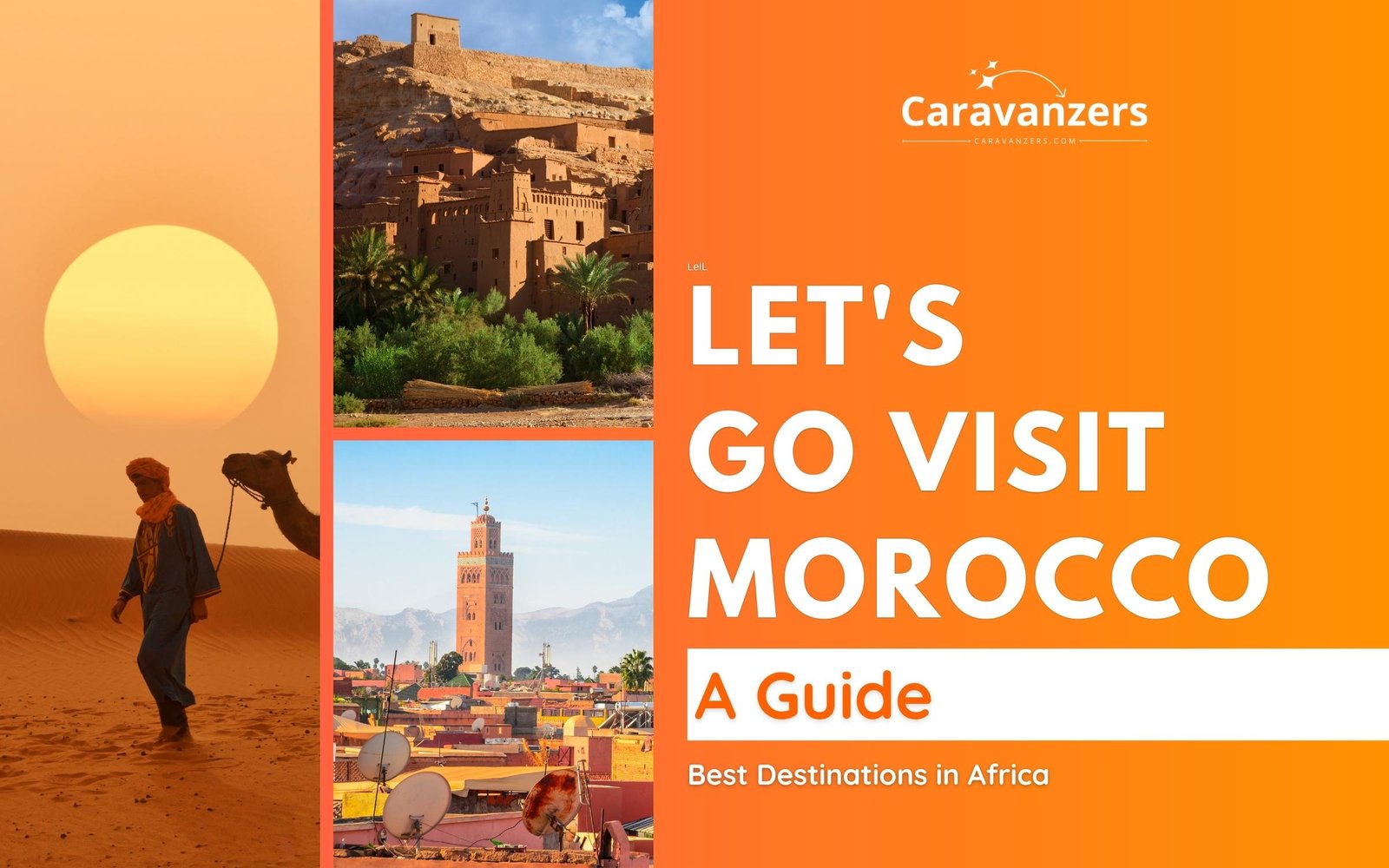
Morocco travel. Come and discover this popular North African country with unique cultures, beautiful landscapes, and lively cities.
In this comprehensive guide, you will learn that Morocco has diverse experiences for every traveler.
This is why it’s one of the top countries in Africa.
From the bustling streets of Casablanca to the captivating medinas of Marrakesh and the tranquil coastal towns of Essaouira and Tangier, this is an awesome country to travel in.
Immerse yourself in the rich history and architectural wonders, explore vibrant markets filled with tantalizing flavors, and embark on adventures through majestic mountains and vast desert landscapes.
Thus, I will start with the basics, like what you need to get there.
After that, I will move on to destinations to visit, what to eat, and things to do.
So, if you’re ready for an incredible trip through Morocco, keep reading!
Morocco Tourism
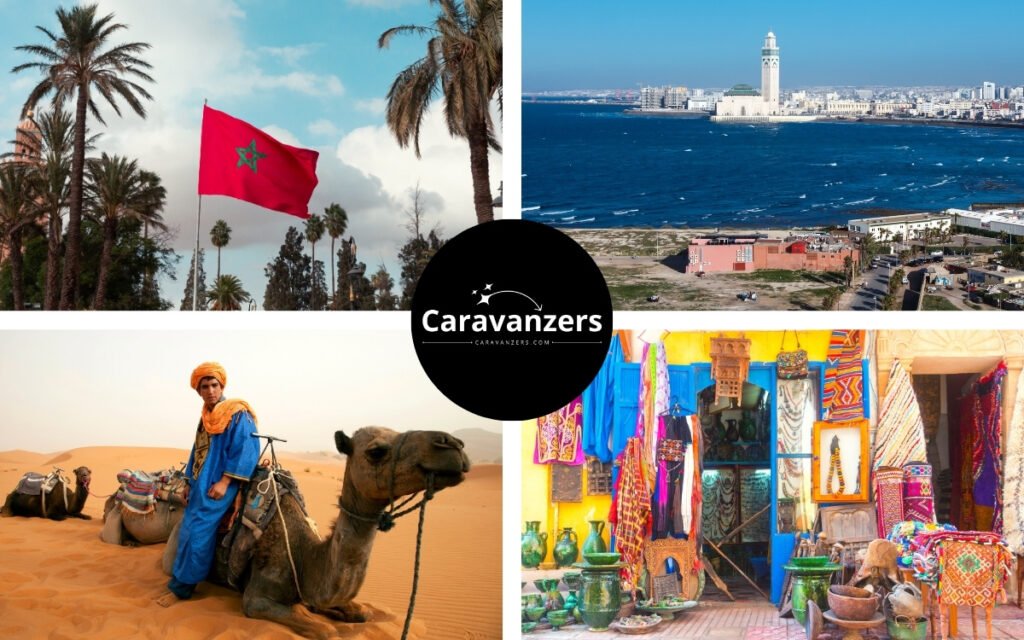
Morocco is popular with tourists for several reasons.
Its vibrant culture, rich history, and diverse landscapes attract visitors, including the Atlas Mountains, Sahara Desert, and coastal regions.
The country offers unique experiences like exploring ancient cities such as Marrakesh and Fes, indulging in delicious Moroccan cuisine, and immersing in the lively atmosphere of its markets and festivals.
Tourists visiting Morocco typically require a visa.
The process involves submitting an application and necessary documents to the nearest Moroccan embassy or consulate.
Tourist visas are usually valid for 90 days and allow multiple entries.
Visitors must ensure their passport remains valid for at least six months beyond their intended departure date.
Morocco has several main airports catering to domestic and international flights.
The major ones include Mohammed V International Airport in Casablanca, Marrakech-Menara Airport in Marrakech, Fes-Saïss Airport in Fes, Rabat-Salé Airport in Rabat, and Agadir-Al Massira Airport in Agadir.
These airports serve as key entry points for travelers visiting Morocco.
The official currency of Morocco is the Moroccan dirham (MAD).
It is the only legal tender accepted throughout the country.
Foreign currencies are not widely accepted, so it is advisable to exchange currency upon arrival.
Banks, exchange offices, and ATMs are available in major cities and tourist areas.
Transportation options from airports to cities in Morocco include taxis, airport shuttles, private transfers, and public transportation.
Taxis are available outside the airports, and it’s advisable to negotiate the fare beforehand.
Some airports offer shuttle services to popular destinations.
Private transfers can be prearranged, while public buses or trains connect airports with city centers.
And you definitely must have the food.
When to Go to Morocco
The best time to visit Morocco largely depends on your personal preferences and the specific experiences you’re seeking.
Morocco experiences a diverse climate due to its geographic location, with coastal areas, mountains, and the desert.
Generally, the most favorable time to visit is during the spring (March to May) and fall (September to November) seasons.
Spring in Morocco is delightful, with mild temperatures and blooming landscapes.
It’s an excellent time to explore cities like Marrakech, Fez, and Casablanca, as the weather is pleasant for sightseeing and outdoor activities.
The Atlas Mountains are particularly beautiful during this time, with lush green valleys and vibrant flora.
Similar to spring, the fall season brings mild temperatures and less crowded tourist destinations.
It’s a great time to enjoy Morocco’s cultural festivals, such as the Imilchil Marriage Festival or the Erfoud Date Festival.
Coastal cities like Essaouira and Agadir are ideal for beach lovers, with warm waters and comfortable temperatures.
However, it’s important to consider the specific region you plan to visit.
Coastal areas like Tangier or Essaouira have milder temperatures throughout the year, making them suitable for a visit, even during summer or winter.
The Sahara Desert experiences extreme temperatures, so it’s advisable to avoid the peak summer months (June to August) and consider visiting in spring or fall when the weather is more bearable.
In summary, the spring and fall seasons offer pleasant weather, fewer crowds, and a wide range of experiences in Morocco.
However, be sure to check the specific climatic conditions and activities available in the region you plan to visit, as they may influence your decision.
What to Know Before Going
Visiting Morocco, a country rich in history and culture, offers an incredible experience for tourists.
That said, you need to know that there are certain aspects to be aware of for your Moroccan trip.
In this section, I will highlight important factors to consider while exploring Morocco: religion, dressing modestly, and staying cautious against petty crime and illegal activities.
So, please, pay attention here as it can help you be careful in Morocco.
Religion in Morocco
Religion in Morocco plays a significant role in society and daily life.
The country is predominantly Islamic, with Islam being the state religion.
Islam influences various aspects of Moroccan culture, including traditions, festivals, and social norms.
Mosques are important centers for worship and community gatherings.
Morocco also respects religious diversity and recognizes the presence of other faiths, such as Christianity and Judaism, with their respective communities living harmoniously with the dominant Islamic culture.
For example, there are about 50 churches in Morocco, and the country used to have a sizeable Jewish minority before they mostly went to Israel.
A growing number of spiritual travelers also settle in Morocco, mostly digital nomads who practice diverse lifestyles, including yoga.
So, be aware of religion, but it isn’t as much of an issue as some other Muslim countries in the region.
Ramadan in Morocco
Ramadan, the holy month for Muslims, can present some inconveniences for visitors to Morocco.
During this time, observant Muslims fast from dawn to sunset.
As you can imagine, this means many restaurants and cafes may be closed or have limited hours during daylight hours.
Meanwhile, respecting the fasting tradition by not consuming food or drinks in public is important since people will be hungry.
Additionally, some attractions and shops may have reduced operating hours.
While experiencing the cultural significance of Ramadan can be fascinating, visitors should be prepared for potential limitations on dining and entertainment options during their stay.
If you can, plan ahead and avoid Ramadan in major cities.
Dress Modestly
Modesty is a significant concern for tourists visiting Morocco.
Respecting the local culture and traditions is crucial, and dressing modestly is an important aspect of that.
Both men and women should opt for clothing that covers their shoulders, knees, and cleavage in villages, small towns, and places that aren’t used by tourists.
This demonstrates respect towards the conservative nature of Moroccan society and helps visitors avoid unwanted attention or offense.
Modesty extends beyond attire to behavior as well.
Being mindful of public displays of affection and refraining from loud or disruptive behavior in religious or conservative areas is essential.
Embracing modesty fosters a positive cultural exchange and promotes harmony between visitors and the local community.
If you visit holy sites in Morocco, including mosques and Sufi shrines, make sure to cover your head if you’re a woman, and men should not wear shorts.
Your trip to Morocco will be amazing, but you just need to consider the local sentiments.
Beware of Petty Crime
When visiting major cities in Morocco, tourists should exercise caution regarding petty theft.
Be vigilant and monitor your personal belongings throughout your trip to Morocco, especially in crowded areas, markets, and public transportation.
Pickpocketing is a common issue in all of the big cities of Morocco, so carrying a secure and concealed bag is recommended.
Avoid displaying valuable items and keep passports, wallets, and phones in secure pockets.
Be cautious of distractions or individuals trying to engage in overly friendly conversations.
It is also wise to use reputable transportation options and avoid isolated or poorly lit areas, particularly at night.
Just keep in mind that the majority of Moroccans are actually poor.
The average monthly salary in most of Morocco is less than $500.
So, expect people to turn to petty crime, including cheating you at markets.
Be Careful with Prostitution
Prostitution in Morocco is illegal, yet it remains a prevalent issue within this country, and you will immediately see that.
Regardless of the legal restrictions, the practice is widespread across Morocco, particularly in tourist hotspots.
Tourists should exercise caution as engaging in or soliciting sexual services can lead to legal consequences.
So, the government takes this issue seriously, and therefore, tourists need to be aware of the laws and cultural norms.
Engaging in illegal activities can result in legal trouble, exploitation, and risks to personal safety.
Travelers should prioritize their well-being and make informed choices while being mindful of the legal framework in Morocco.
If someone approaches you in any of the medinas or other tourist areas across Morocco, be ready to be polite but firm.
Destinations in Morocco
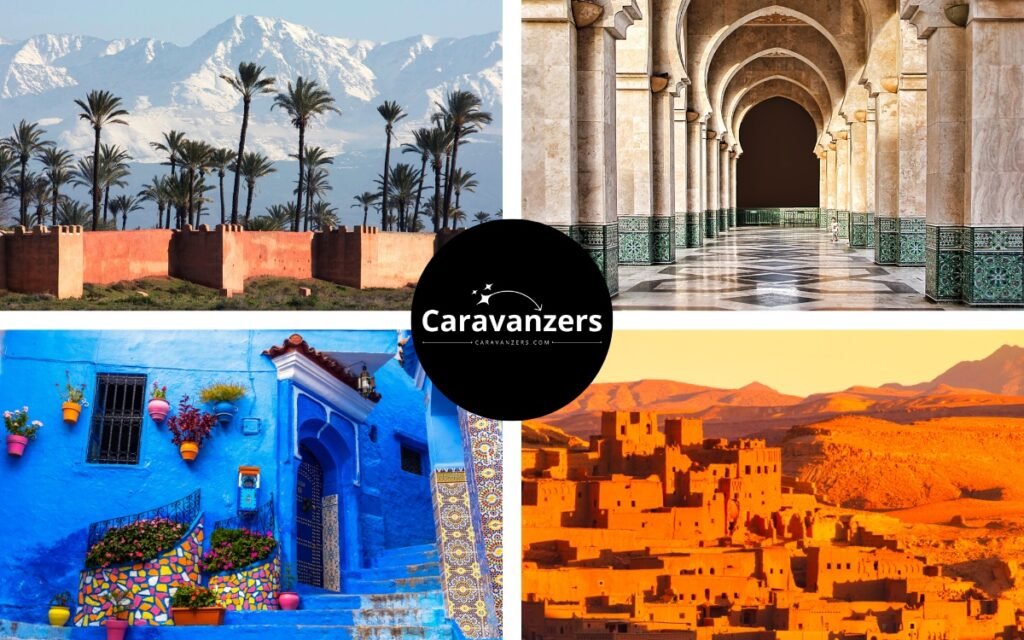
Morocco is known for its vibrant culture, mesmerizing landscapes, and bustling cities.
Casablanca, Marrakesh, Tangier, Essaouira, and Chefchaouen stand out among its numerous enchanting destinations.
Each of these Moroccan gems offers a unique blend of history, architecture, and local flavors, creating unforgettable experiences for travelers.
Whether exploring historic landmarks, immersing in vibrant markets, or indulging in seaside tranquility, these destinations have something to captivate every traveler.
Casablanca
Casablanca, located along the coast of the Atlantic Ocean, is a sprawling city.
It’s Morocco’s largest and most cosmopolitan city.
Its rich history and architectural wonders complement the city’s modern and bustling atmosphere.
One of the must-see landmarks is the Hassan II Mosque, an impressive masterpiece of Islamic architecture, with its towering minaret overlooking the sea.
This coastal city also has a lively nightlife, yummy restaurants, and unique shopping experiences.
It is a perfect destination for those seeking a blend of culture and modernity.
Marrakesh
Nestled in the heart of Morocco, Marrakesh is a captivating city that enthralls visitors with its lively souks, intricate palaces, and vibrant medina.
The city’s centerpiece, Jemaa el-Fnaa, is a bustling square with snake charmers, storytellers, and food stalls serving delectable Moroccan cuisine.
Marrakesh is also famous for its stunning palaces, such as the Bahia Palace and the El Badi Palace, showcasing the city’s rich architectural heritage.
Exploring the medina’s labyrinthine streets, discovering hidden riads, and indulging in traditional hammam experiences are all part of the enchanting journey through Marrakesh.
Tangier
Tangier lies at the country’s northernmost tip, and crossing over to Spain takes just an hour.
Its unique blend of European and Moroccan influences has always attracted artists, writers, and travelers.
Throughout history, the city’s strategic position at the Strait of Gibraltar has turned it into a melting pot of cultures.
Tangier’s rich history is showcased in its medina, where narrow streets are lined with traditional shops and cafes.
Strolling along the lively waterfront promenade, known as the Corniche, visitors can enjoy stunning views of the Mediterranean Sea.
Meanwhile, the city houses the American Legation.
It serves as a museum and cultural center. It holds the distinction of being the first American public property outside the United States.
Essaouira
Essaouira, a charming seaside town, sits on the Atlantic coast and is renowned for its picturesque beaches, fortified walls, and artistic atmosphere.
Colorful shops selling local handicrafts and artwork fill the maze of narrow alleyways in the city’s medina, a UNESCO World Heritage site.
Thanks to the consistent trade winds that grace its shores, Essaouira is famous for coastal activities like windsurfing and kitesurfing.
With its relaxed atmosphere, fresh seafood, and lively music, Essaouira offers the ideal getaway from the bustling nature of other Moroccan cities.
Chefchaouen
Nestled in the Rif Mountains, Chefchaouen is a magical town renowned for its blue-washed buildings that create a dreamlike atmosphere.
As you wander through its streets, the calming hues of blue create a tranquil ambiance, inviting visitors to slow down and appreciate the town’s beauty.
Chefchaouen’s medina is a treasure trove of artisanal shops selling traditional crafts and textiles.
The town also offers breathtaking panoramic views from its hilltop vantage points, where visitors can capture stunning photographs of the blue cityscape.
With its unique charm and serene surroundings, Chefchaouen is a must-visit destination for those seeking an escape into tranquility.
What to Eat in Morocco
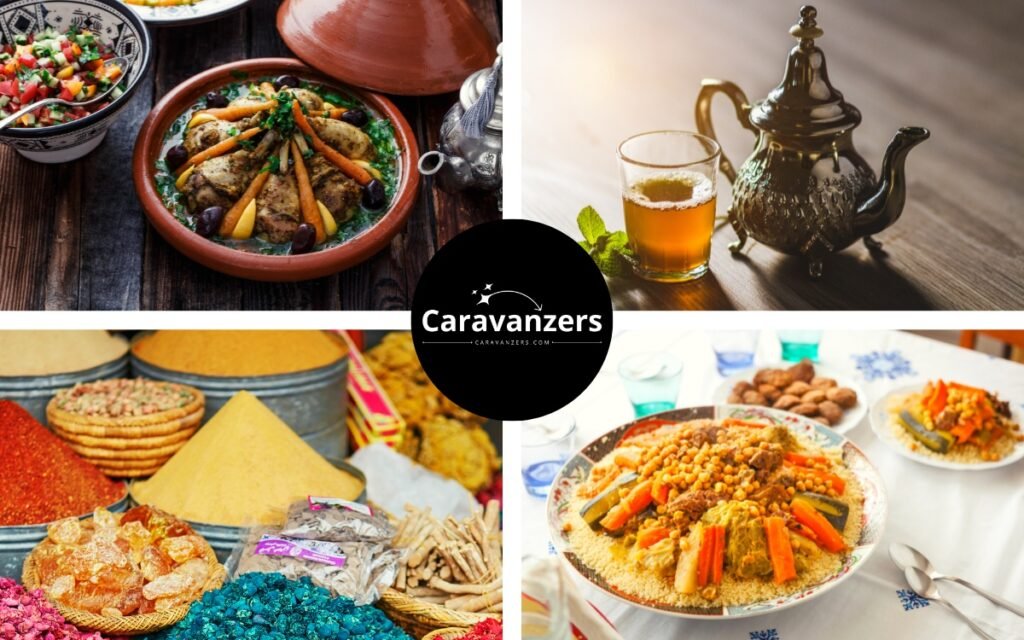
Morocco boasts a rich and diverse culinary heritage influenced by various cultures and traditions.
The food in Morocco is a harmonious blend of Berber, Arab, African, French, and global influences.
From the fragrant tagines and couscous of the Berber tradition to the aromatic spices of Arab cuisine, the bold flavors of African dishes, the delicate pastries influenced by the French, and the diverse global culinary offerings, Morocco offers a tantalizing array of food that captivates the senses and reflects the country’s multicultural heritage.
Berber Food
Firstly, Berber food plays a significant role in Moroccan cuisine.
The Berber is indigenous to North Africa and has contributed unique flavors and techniques to the country’s culinary tapestry.
Traditional Berber dishes often feature staple ingredients such as couscous, lentils, and chickpeas.
One popular dish is tagine.
This is a slow-cooked stew prepared with diverse items.
For example, a popular version is with lamb, vegetables, and aromatic spices like cumin, coriander, and saffron.
Berber cuisine also incorporates dried fruits, nuts, and honey, resulting in a delightful blend of sweet and savory flavors.
Arab Food
Arab cuisine also exerts a profound influence on Moroccan gastronomy.
With the Arab conquest of the region, their culinary practices and ingredients were introduced and integrated into Moroccan cooking.
Arab food is famous for using fragrant spices like cinnamon, ginger, and turmeric.
So, this is due to the region’s historic trade with India, China, and Egypt.
These spices add depth and complexity to dishes.
Moroccan cuisine showcases Arab favorites such as shawarma, kebabs, and flavorful rice dishes.
Additionally, dishes like harira, a hearty soup made with lentils, tomatoes, and lamb, are enjoyed throughout the country, particularly during Ramadan.
Non-Moroccan African Food
Morocco’s geographic location in North Africa infuses its cuisine with African flavors and ingredients.
African food in Morocco often incorporates vibrant spices and bold flavors.
For instance, chili peppers, garlic, and paprika add a fiery kick to dishes like chermoula-marinated grilled fish.
African-inspired dishes also feature ingredients like okra, millet, and peanuts, adding diversity and richness to the culinary landscape of Morocco.
French Food
During the French colonization, French culinary traditions left a lasting impact on Moroccan cuisine.
French food in Morocco often manifests in pastries, bread, and café culture.
Many Moroccan patisseries and cafes enjoy classic French pastries like croissants, pain au chocolat, and macarons.
The French influence also extended to savory dishes, introducing quiche, ratatouille, and coq au vin, adapted to incorporate local Moroccan ingredients and flavors.
Global Food
Lastly, Morocco’s connection to the wider world has brought about a fusion of global flavors within its culinary landscape.
Moroccan cities boast a diverse range of international restaurants, offering cuisines from around the globe.
From Italian pizza and pasta to Asian stir-fries and sushi, global food options cater to diverse palates and preferences.
Tourists and locals can indulge in various international flavors, embracing a global culinary experience while savoring the distinct Moroccan touch.
Things to Do in Morocco
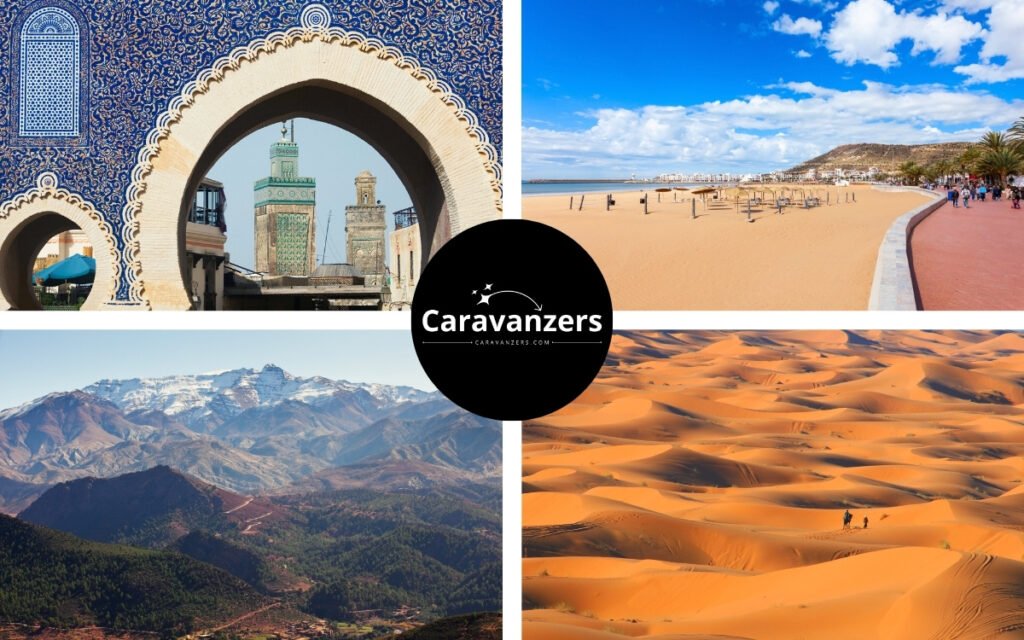
Morocco offers a diverse range of attractions catering to all travelers.
This North African gem has something for everyone, from captivating tourist attractions and sun-kissed beaches to majestic mountains and vast desert landscapes.
Morocco’s abundance of tourist attractions, stunning beaches, majestic mountains, and mesmerizing desert landscapes offer travelers a wide array of experiences.
Whether you’re seeking cultural immersion, outdoor adventures, or relaxation, Morocco will surely leave you captivated and inspired.
Tourist Attractions
Morocco has numerous tourist attractions showcasing its rich history, vibrant culture, and architectural marvels.
One must-visit destination is the enchanting city of Marrakech, known for its bustling souks, stunning palaces like Bahia Palace and El Badi Palace, and the iconic Koutoubia Mosque.
Another popular spot is Fes, a UNESCO World Heritage site renowned for its medieval medina, ancient tanneries, and Al-Qarawiyyin Mosque.
Other notable attractions include the Roman ruins of Volubilis, the charming blue city of Chefchaouen, and the coastal town of Essaouira.
Beaches
Morocco’s long coastline along the Atlantic Ocean and the Mediterranean Sea is adorned with picturesque beaches.
Agadir, located on the southern coast, offers a bustling beach scene with a wide range of water sports activities.
Essaouira, known for its vibrant blue boats and windswept shores, is a paradise for surfers and kitesurfers.
For a more tranquil beach experience, head to the secluded coves of Legzira or the untouched beauty of Sidi Kaouki.
Travelers love to relax under the sun, indulge in water sports, or enjoy a leisurely stroll on Morocco’s beaches, which seem to have everything.
Mountains
The Atlas Mountains dominate the Moroccan landscape, offering breathtaking vistas and opportunities for outdoor adventures.
The High Atlas range is a hiker’s paradise, with Mount Toubkal as North Africa’s highest peak.
Trekking trails in this region lead to charming Berber villages, where you can immerse yourself in traditional mountain culture.
Suppose you prefer a more relaxed mountain experience. In that case, the picturesque town of Ifrane is nestled in the Middle Atlas. It offers stunning alpine landscapes, ideal for leisurely walks or picnics.
The Desert
No visit to Morocco is complete without exploring its vast desert landscapes.
The Sahara Desert stretches across the southeastern part of the country.
It truly captivates travelers with its golden dunes and serene ambiance.
Embark on a camel trek or a 4×4 desert safari to witness mesmerizing sunrises and sunsets over the Erg Chebbi dunes in Merzouga or the Erg Chigaga dunes near Zagora.
Spending a night in a traditional desert camp is a unique experience.
You will marvel at the starry night sky and experience the warm hospitality of the local nomadic tribes.
14-Day Morocco Trip Itinerary
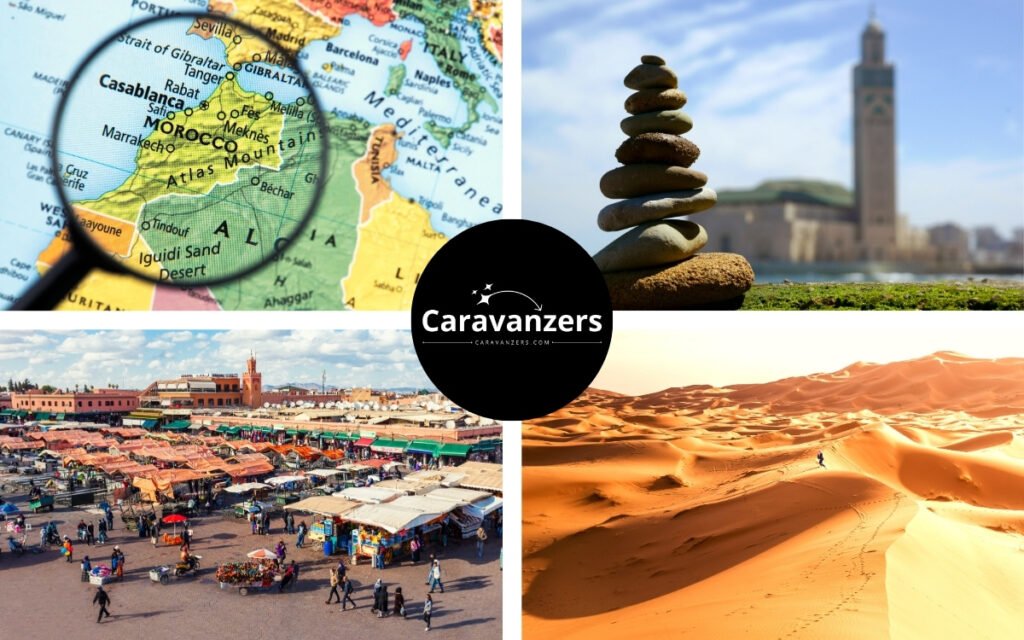
Morocco is known for its vibrant culture, mesmerizing landscapes, and bustling cities.
Casablanca, Marrakesh, Tangier, Essaouira, and Chefchaouen stand out among its numerous enchanting destinations.
Each of these Moroccan gems offers a unique blend of history, architecture, and local flavors, creating unforgettable experiences for travelers.
Whether exploring historic landmarks, immersing in vibrant markets, or indulging in seaside tranquility, these destinations have something to captivate every traveler.
Go on the following 14-day itinerary through Morocco and discover the magic this North African country offers.
Week 1 Itinerary
On Day 1, you’ll arrive in Casablanca, Morocco’s largest and most cosmopolitan city.
It’s a bustling metropolis with a modern atmosphere.
Don’t miss the iconic Hassan II Mosque, a magnificent masterpiece of Islamic architecture that overlooks the sea.
When evening comes, dive into the vibrant nightlife, try the delicious local restaurants, and explore the city’s unique shopping experiences.
Days 2 and 3 will take you to Marrakesh, a captivating city known for its lively souks and intricate palaces.
Get lost in the bustling atmosphere of Jemaa el-Fnaa Square, where you’ll encounter a vibrant mix of sights and sounds.
Explore architectural wonders like the Bahia Palace and the El Badi Palace, and wander through the maze-like streets of the medina to discover hidden riads.
And, of course, indulge in a traditional hammam experience to immerse yourself in the local culture.
On Days 4 and 5, you’ll journey to Tangier, a city beautifully blends European and Moroccan influences.
Immerse yourself in the historic medina, where traditional shops and cafes are lining its narrow streets.
And don’t forget to visit the American Legation, an important museum and cultural center that holds historical significance as the first American public property outside the United States.
Days 6 and 7 will be dedicated to relaxation in Essaouira, a charming seaside town on the Atlantic coast.
Enjoy the picturesque beaches and try exciting coastal activities like windsurfing and kitesurfing.
Take a leisurely stroll through the UNESCO World Heritage medina, where you’ll find colorful shops selling local handicrafts.
Week 2 Itinerary
After immersing yourself in Morocco’s vibrant cities and bustling atmosphere, it’s time to head to Chefchaouen, a truly magical town famous for its blue-washed buildings.
Take your time to explore the medina, where you’ll find artisanal shops filled with traditional crafts and textiles, allowing you to discover unique treasures to bring back home.
Don’t forget to climb up to the hilltop vantage points, where breathtaking panoramic views of the blue cityscape await, providing the perfect backdrop for memorable photographs.
Continue your Moroccan adventure by immersing yourself in the country’s rich culinary heritage during days 11 and 12.
Indulge in a delightful array of flavors as you sample traditional Berber dishes like lamb tagine, infused with aromatic spices that transport you to a world of tantalizing tastes.
Explore Arab favorites such as shawarma and flavorful rice dishes, each bite a delightful explosion of Middle Eastern flavors.
Dive into African-inspired dishes, vibrant with bold spices and enticing aromas.
And, of course, experience the French influence with pastries and savory delights that reflect Morocco’s historical connection with France.
Embark on a global culinary journey, savoring international flavors in the vibrant cities of Morocco, where every meal is a delightful adventure.
For the final days of your trip, embrace the natural wonders of Morocco.
Relax on the picturesque beaches of Agadir or Essaouira, where the sun-kissed shores invite you to unwind and soak up the coastal beauty.
Embark on a hiking expedition in the awe-inspiring Atlas Mountains, where breathtaking vistas and pristine landscapes await at every turn.
And don’t miss your chance to venture into the Sahara Desert because you will witness the golden dunes stretching as far as the eye can see.
Morocco Travel – Final Thoughts
Morocco calls with its captivating allure, inviting you to embark on a journey filled with unique cultures, breathtaking landscapes, and vibrant cities.
This travel guide has provided a comprehensive overview, revealing the diverse experiences awaiting every traveler in this North African gem.
From the bustling streets of Casablanca to the enchanting medinas of Marrakesh and from the tranquil coastal towns of Essaouira and Tangier to the awe-inspiring mountains and vast deserts, Morocco offers an abundance of wonders to explore.
So, start planning today if you’re ready to go on an incredible trip through Morocco, filled with cultural immersion and breathtaking experiences.
Enjoy Morocco!
AJ Paris is a travel photographer based in New York. He is the editor of Caravanzers.
Follow us on Pinterest.

It is the best time to make a few plans for the longer
term and it’s time to be happy. I have read this publish and
if I may just I want to recommend you some fascinating things or
tips. Maybe you can write subsequent articles relating to this article.
I desire to learn more things about it!